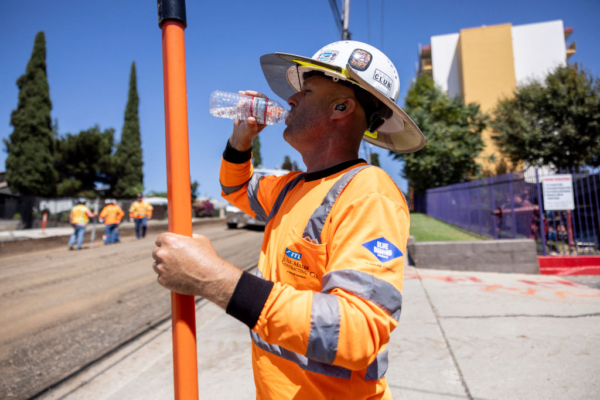The central and western United States typically experience cooler weather as October arrives, but this year is proving to be unusually hot in many areas. Cities like Phoenix, Las Vegas, Los Angeles, and the eastern regions of San Diego County and the San Francisco Bay Area are all facing extreme high temperatures.
On October 2nd, in areas like Arcadia, Diamond Bar, and Walnut City in eastern Los Angeles, the temperatures were above 90 degrees Fahrenheit around 4 p.m. The high temperatures are expected to last until early next week before easing.
According to data from the National Weather Service, a total of 14 cities from Southern California to the San Francisco Bay Area have broken temperature records.
Palm Springs in Southern California hit a high temperature of 117 degrees this Tuesday, setting a new record for the city on the same day. The low temperature that day also set a record, staying above 82 degrees even during the night.
The Central Valley region also set daily high temperature records on Tuesday, with temperatures on Wednesday and Thursday nearing all-time highs for the month.
Even in the typically cool city of San Francisco, temperatures reached 95 degrees on Tuesday, compared to the record of 97 degrees back in October 1980.
In another major city in the Bay Area, San Jose reached 100 degrees on Tuesday and around 102 degrees by 4 p.m. on Wednesday.
Coastal cities, however, had much more comfortable weather. In Santa Monica, a coastal city in Los Angeles, temperatures were about 25 degrees cooler than cities just 20 miles inland, reaching around 70 degrees by 4 p.m. on Wednesday.
In the usually hot Phoenix, Arizona, temperatures in the first few days of October also broke records. The city reached 113 degrees on Tuesday, marking the first time it surpassed 110 degrees in October.
Las Vegas also tied its highest temperature record for the day set back in 1978, with a high of 103 degrees on Tuesday.
The current heatwave across the western United States is pushing temperatures 10 to 25 degrees above normal, leading to heat alerts for a total of 36 million people in California, Nevada, and Arizona.
Both Arizona and California have experienced their hottest summers on record this year, according to the National Oceanic and Atmospheric Administration.
Meteorologist Ted Whittock from the National Weather Service in Phoenix explained to Axios that the ongoing heatwave is due to a strong high-pressure system hovering over the Western U.S. last week, preventing cooler weather and precipitation from reaching the region’s valleys. This phenomenon also explains the high temperatures in other parts of the West.
The high-pressure system typically moves west to east and can linger in one place for days or weeks. As a result, the trapped hot air underneath creates a “heat dome” in the covered area, leading to scorching temperatures. The heated air below the heat dome continues to rise and get compressed, further increasing temperatures and causing dry, hot weather.
Such weather conditions are usually seen in July and August, but this year, the heat dome is persisting into October.
The National Weather Service warns that the current high temperatures could increase wildfire risks. Red flag warnings for severe fire danger have been issued in parts of California, Colorado, Montana, Nebraska, South Dakota, and Wyoming.
Forecasters predict that 20 counties in the San Francisco Bay Area, Central Coast, Inland Empire, and Southern California will experience extreme high temperatures. In the heat advisories issued, the Governor’s Office of Emergency Services reminds Californians to take necessary precautions to protect themselves, including checking on friends and neighbors who live alone as they are more susceptible to the effects of high temperatures.
The Centers for Disease Control and Prevention warn that the hot weather increases the risk of certain diseases, particularly for individuals over 65, children under 2, and those with mental illness or other chronic conditions who need to be extra cautious about the health risks posed by high temperatures.
The California Department of Public Health issued warnings urging the public to prevent heat exhaustion and heatstroke. The California Department of Labor Relations also reminded employers to take steps to protect employees and prevent heat-related illnesses.

